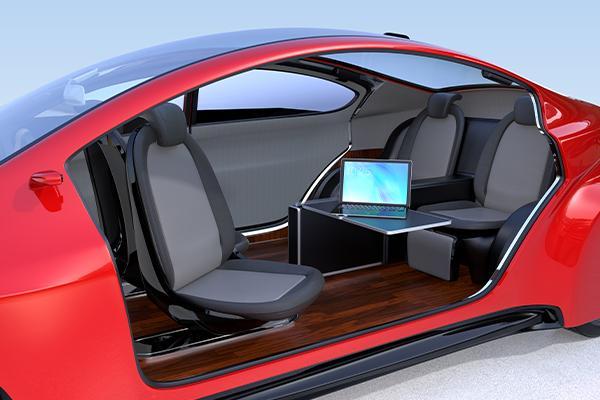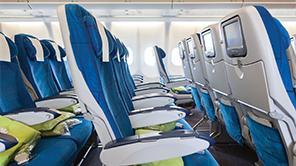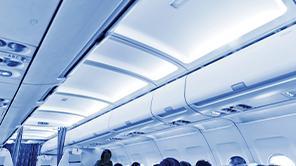Enhancing Autonomous Vehicle Interior Design with Proven Access Solutions

While the technology necessary to deploy fully autonomous vehicles is on the brink of being realized, consumer psychology and passenger trust continue to be roadblocks to widespread adoption of autonomous automobiles.
Lack of consumer trust in new innovations is not a new concept, as consumers have long been wary to trust machines with something as valuable as their own lives. Now, as drivers relinquish their responsibility for controlling their vehicles and transition to hybrid driver-passenger roles, designers are presented with the challenge of creating a functional interior that not only provides comfort, but also builds trust and alleviates passenger fear.
For Automotive designers, creating an interior space that allows passengers to feel comfortable and able to trust a vehicle’s Artificial Intelligence to safely transport them from one location to another presents new challenges.
However, opportunities for inspiring passenger trust exist in all of the vehicle’s interior touch points. From adjustable monitors that relay key trip information to the passenger, to new amenities like stowable tray tables and even bunks, the key is keeping the passenger informed and at ease for the duration of their voyage.
Automotive OEMs can ensure a safe, smooth and efficient transition to the driverless experience by incorporating proven mechanisms designed with integrated constant torque positioning technology and secure, hidden latching solutions into the common touch points of new autonomous interior designs.
Predicting Passenger Needs
The advancement of autonomous vehicle technologies necessitates a complete reimagining of the passenger experience. When the human driver is no longer responsible for controlling the vehicle, a new world of possibilities is created for the passenger with regard to how they choose to spend their travel time.
For OEMs, current interior concepts for autonomous vehicle design can be segmented into two categories: traditional and non-traditional. Traditional interiors maintain many of the details ubiquitous in modern vehicles: a steering wheel and fixed, forward-facing seating. Non-traditional interiors reimagine the vehicle without the need for a driver. The steering wheel can be tucked away, with large displays and screens taking up surface areas and re-configurable and removable seating options available.
As OEMs settle on design strategies for autonomous vehicle interiors, their decisions will have major implications for both passenger comfort and trust. While non-traditional interiors may open greater possibilities for the entertainment and comfort of the passenger, traditional interiors are much more likely to inspire the familiarity that is crucial for maintaining passenger trust.
Establishing and Maintaining Passenger Trust
A Deloitte survey conducted in 2018 revealed that 47% of the US population would not trust an autonomous vehicle to transport them.[1] This deficit in passenger trust poses a design challenge that has the Automotive industry asking itself: how can autonomous vehicles be designed to inspire more trust in passengers?
For over a decade, advanced driver-assistance systems (ADAS), such as automatic braking or parking assistance, have represented the most widespread use of automation in passenger vehicles, yet 40% of drivers report that they are still occasionally startled by the actions of their ADAS-equipped vehicle, and 84% report that they trusted their own driving abilities more than those of the vehicle.[2]
The lack of trust on the part of passengers correlates to the abrupt surrender of decision-making from the driver to the autonomous vehicle, with passengers often becoming anxious when they are unable to anticipate the next move of the vehicle.
One strategy for reducing this problem is the use of heads-up displays (HUDs) within the vehicle. These transparent displays present data and information within the normal line of sight of the passenger.
While HUDs have played an important role in the operation of military and commercial aircraft for several decades, the technology remains largely untested in the Automotive industry. The incorporation of HUDs into autonomous vehicles will play the crucial role of communicating the vehicle’s intent – adjustments in speed and lane changes, for instance – at all times to the passenger, and providing an augmented reality experience that alleviates passenger fears.
With the passenger now able to anticipate the moves of the autonomous vehicle, they are less likely to be startled by a sudden change in speed or direction. This consistent communication is essential to building the trust necessary for drivers to transition to autonomous vehicles.
To accommodate differences in passenger height, modular vehicle configurations, and even changes in brightness based on the weather and time of day, HUD display mounts will need to be easily adjustable. Mounting hardware must also be rugged enough to handle the various forces and vibrations encountered when driving at high speeds and on changing terrains.
Designing for Passenger Comfort
Another challenge in designing for the AV interior is the propensity for vehicle passengers to experience motion sickness. Studies have shown that motion sickness is often caused by looking down or reading while traveling in a moving vehicle. This is due to how the brain processes perceive the body to be standing still, and the inner ear, which is still able to perceive changes in speed and direction.
For designers aiming to elevate passenger comfort in autonomous vehicles, new equipment will need to encourage the passenger to look up rather than down. Adjustable tray tables and variety of displays and screens will need to be designed to function at eye level or above, and they will need to be adjustable to accommodate the varying heights and individual preferences of passengers.
AV interior designers can improve the functionality of these applications by incorporating hinges and display mounts designed with constant torque positioning technology. Constant torque hinges use engineered friction systems to provide continuous resistance against motion, making a lightweight plastic table or tray feel heavier and more substantial, thus improving the passenger experience.


Since constant torque hinges provide resistance throughout the entire range of motion, this allows the user to easily adjust a tray, keeping it in any position the user desires. Southco’s asymmetric torque hinges for instance, allow a table to be lifted with little effort by the passenger, it but contain enough resistance to stop it from falling or dropping unexpectedly. This allows the passenger to focus on enjoying their ride, without having to constantly look down and readjust.
Benefits of Positioning Technology
Southco’s trusted precision position control products, which rely on controlled torque, can provide a safer and more reliable experience when interacting with HUDs. Hinges and display mounts that are designed with pre-engineered constant torque technology provide a full range of motion that improves passenger ergonomics and usability, offering the following design benefits:
- Able to withstand vibration and inertial loading that may result while the vehicle is in operation
- Can be moved in multiple directions and angles, allowing displays to be easily pulled toward or pushed away from the passenger as needed
- One-handed operation allows simple one-touch positioning of displays
- Reliable, repeatable cycle life that eliminates the need for service or adjustment during operation
Ensuring Safety in New Passenger Environments
The introduction of new storage spaces, HUDs and other equipment greatly increases the number of passenger touch points that must operate safely and efficiently. All changes and new additions to autonomous vehicle interiors will need to meet rigorous safety standards to ensure the well-being of passengers. This equipment must be robust enough to withstand a potential accident without posing additional harm to the passenger.
Manufacturers considering non-traditional designs of autonomous vehicle interiors will be faced with an expanded responsibility in anticipating the various safety challenges of new vehicle configurations. Modular seating options for instance, will need to meet safety standards in all possible configurations, and adjustable equipment will require tight fastening to prevent injury. Each touch point must be constructed with sturdy, well-designed components to deliver safe performance at all times and in all situations.
Tray tables and other interior features may also need be stored to provide more space within the vehicle. Storage panels designed with hidden latching solutions allow passengers to easily and effortlessly stow away functional elements of the interior due to the flexibility that they provide.
Push-to-close latching and dual point latching systems offer a reliable solution for numerous design challenges within the autonomous interior, and ensure that interior doors and panels remain closed and latched securely when the vehicle in in motion.
Coupler systems that feature a two-point, dependent pawl latching mechanism can help prevent the risk of false latching and keep storage panels closed while the vehicle is in motion. Southco’s Dual Point Coupler System offers secure latching and flexibility of actuation styles to allow for changing design needs. Constructed of lightweight engineered thermoplastics, the system features a cartridge-style installation that allows it to be easily mounted between panels, enabling a clean, flush exterior for a variety of stowable applications.
There are a variety of latch options with differing performance attributes and mounting options to meet the unique needs of autonomous interior applications. Flush mounted latches that offer simple push-to-close convenience, like Southco’s M1 Push-to-Close Latch series provide intuitive operation the passenger when operating “stow and go”, floor storage and load floor applications. The latch design can also be customized to the vehicle’s interior, offering design flexibility.
Envisioning the Vehicle of the Future
It remains to be seen what the autonomous vehicles of the future will look like, and competing OEMs will likely bring differing visions and concepts to the market. As manufacturers introduce new equipment and designs, they will need to think ahead in terms of the products and tools used to implement their vision.
Interior design features, like stowable tray tables, touchscreens and more, will need to incorporate reliable access hardware products like constant torque hinges and hidden latching solutions to accommodate passenger preferences and create a comfortable travel environment. While there is no “one size fits all” interior concept that meets the needs of all autonomous passengers, safe, modular solutions from proven suppliers will be indispensable when gaining passenger trust.
Meeting the Challenges of Autonomous Vehicle Interior Design
Southco’s relationship with the Automotive industry spans decades of experience and innovation. We have a long history as a leading supplier of proven carryover designs and core mechanisms to OEMs and Tier 1 worldwide, including latching, fastening and positioning solutions.
Robust, tested display mounts like the Southco AV series offer a wide range of capabilities to meet interior equipment mounting needs, including tilt, swivel, swing and dual extension. Hidden solutions, like the R4 Rotary or P4 Two-Point Coupler Latches, feature dependable push-to-close operation and a compact, space-saving design that facilitates interior door mounting.
Program Management from Concept to Production
Southco provides total program management, from initial design and prototyping to logistics and service, offering:
- Engineer-to-engineer connectivity
- Drop-in solutions that save design time and suit high volume production
- Industry standard products to meet global compliance specifications
- Localized support with global supply and manufacturing presence



